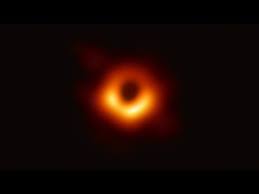This is the second anniversary of our first photograph of a ”black hole, those much-ballyhooed objects that were once the stuff purely of imagination and theory, first posited in a rudimentary way by the lay astronomer John Michell back in 1784: A body with such a Newtonian gravitational ‘pull’ that corpuscles of light would fall upon itself like tiny droplets.
The properties of these strange cosmological objects were outlined more accurately in light of Einstein’s Theory of Relativity (1915), which, in line with its principle of matter-energy equivalence, proved that light – now seen primarily as a wave – could indeed ‘bend’ under the influence of gravity (as proven a few years later, with the warping of starlight around our own Sun). Around the same time, Karl Schwartzchild is credited with the first full theory of a point of matter packed so dense – close to infinitely so – that not even light waves can escape the pull of its immense gravity. When stars collapse, they may form ‘neutron stars’ – think of our own Sun, a million times the size of the Earth, packed into a space the size of a city – where a teaspoon of matter would weigh many tons. But the collapse sometimes continues, on and on, into realms that go beyond what we know of physics.
Black holes are sort of inaptly named. ‘Black’ because they are invisible to an outside observer, except for a ring of light around the ‘event horizon’, the point of no return, beyond which anything falling in can never get back out, entering a region where space and time are warped in ways we cannot (yet?) imagine. Yet within they are blazing infernos of light and energy, brighter than anything we could possibly imagine or (yet) see. What happens to Matthew McConaughey when he falls into one in Interstellar is weird and unreal – parallel universes and all that. What would really happen to you, great minds theorize, is ‘spaghettification’ – yes, that is a real term – with the gravity on your toes being so much greater than the gravity on your upper body that you would be stretched out like a long noodle, before being broken down to your constituent atoms, protons and neutrons, even your quarks, becoming part of the ‘hole’s’ immense energy. Not recommended.
Black holes devour everything in their path – yes, like all objects in space, they do move – and everything that ‘falls in’ makes them more dense, with more gravity, and hence more powerful. One of the larger ones could easily eat our entire solar system for breakfast, or as a mere appetizer (there are videos showing how such a turn of event might unfold). But worry not, for the black hole here pictured is in the M87 galaxy, 15 million light years away – untold trillions of miles, and its faint light from that distance gathered together over years from many layered images of hundreds of telescopes, making the wonderful composite photograph just released. It is also billions of times more massive than our own Sun, with all of that mass compressed into an infinitesimal point. We know not how many black holes there be, but be glad and rejoice in these Easter days, for all the problems we face, at least they are nowhere near our Solar system. Then again, that would certainly divert people’s minds (and bodies) from Covid and climate change. In God’s good providence, black holes must serve a purpose, perhaps as roving inter-stellar vacuum cleaners, tidying up the excess.
The universe is a strange and wonderful place, which should inspire awe in us humans, whirling around our own star, the Sun, as it whirls around our own galaxy taking all of us in its 43,000 miles-per-hour wake, the Sun in turn whirling around we-know-not-what – some ‘great attractor’ at the centre our Milky Way galaxy, itself perhaps another super-massive black hole. So Sun and moon, stars and nebulae, praise the Lord, and give glory to His holy name, Who orders all things well.


